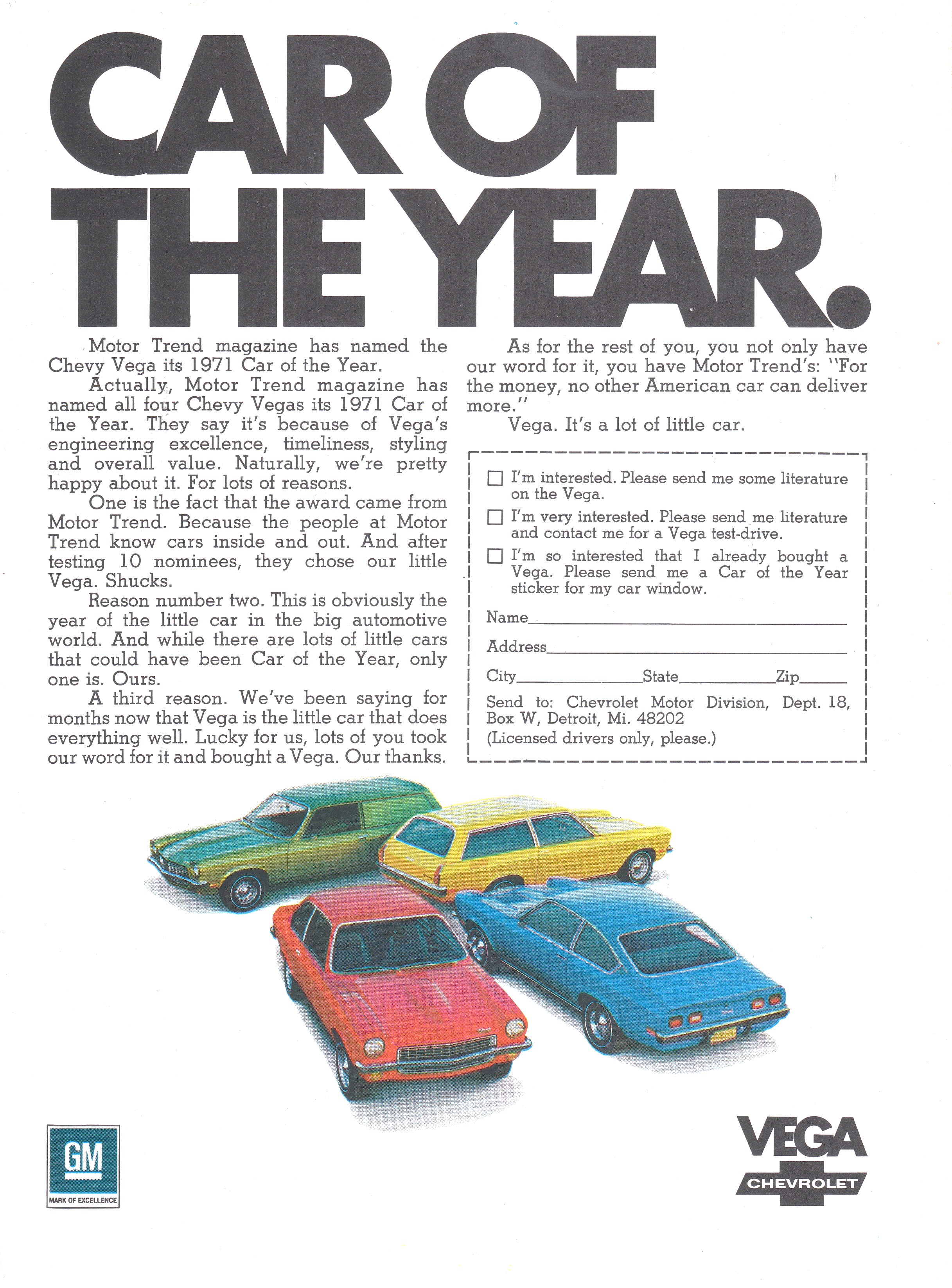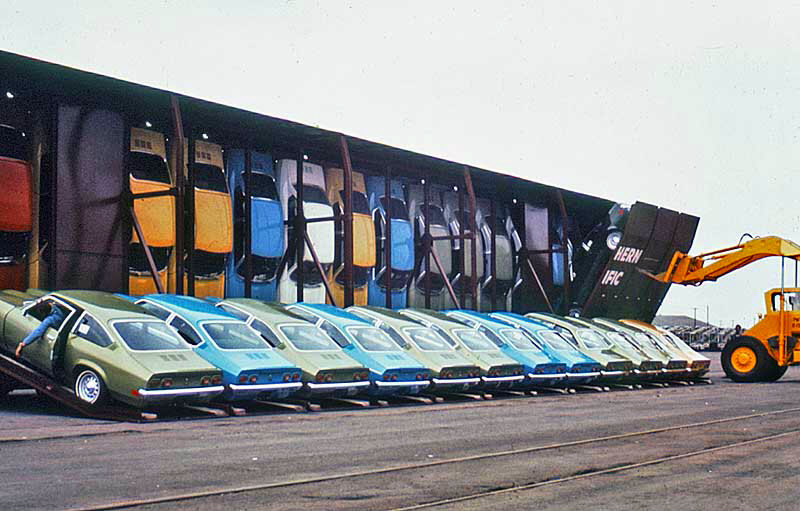When Vegas Took Flight: The Curious Case of the Vert-A-Pac Railcar
January 10, 2024
.jpg) The automotive industry thrives on innovation, with some ideas becoming icons and others vanishing like desert mirages. In the realm of car transportation, few concepts were as unique and short-lived as the Vert-A-Pac railcar. Imagine a train rolling down the tracks, not with dozens of cars neatly lined up, but with 30 Chevrolet Vegas stacked nose-down in vertical compartments. That's the essence of the Vert-A-Pac, a brainchild of the late 1960s born from a collaboration between General Motors and Southern Pacific Railroad.
The automotive industry thrives on innovation, with some ideas becoming icons and others vanishing like desert mirages. In the realm of car transportation, few concepts were as unique and short-lived as the Vert-A-Pac railcar. Imagine a train rolling down the tracks, not with dozens of cars neatly lined up, but with 30 Chevrolet Vegas stacked nose-down in vertical compartments. That's the essence of the Vert-A-Pac, a brainchild of the late 1960s born from a collaboration between General Motors and Southern Pacific Railroad.
Packing 'em in Like Sardines with a Twist:
Fueled by a desire for efficiency and cost-cutting, the Vert-A-Pac aimed to squeeze more Chevy Vegas onto a single railcar than ever before. Traditional tri-level autoracks could handle around 18 cars, but the Vert-A-Pac doubled that figure with its ingenious vertical stacking system.
 Think of it as a high-rise parking garage for trains. The Vert-A-Pac wasn't your ordinary flatcar. It was a modified beast, equipped with hinged doors on each side that folded down to create ramps for loading. Each Vega sported four special sockets on its undercarriage, like little mechanical hands, that perfectly aligned with corresponding hooks on the ramp doors. Once all the cars were loaded onto the ramps, a burly forklift swung into action, lifting and closing the doors. This secured the Vegas in their vertical position, noses pointing towards the tracks below, like fighter jets awaiting launch. To prevent any engine hiccups during the journey, the Vega's engine had a special baffle, and its fuel tank only received a half-hearted fill-up.
Think of it as a high-rise parking garage for trains. The Vert-A-Pac wasn't your ordinary flatcar. It was a modified beast, equipped with hinged doors on each side that folded down to create ramps for loading. Each Vega sported four special sockets on its undercarriage, like little mechanical hands, that perfectly aligned with corresponding hooks on the ramp doors. Once all the cars were loaded onto the ramps, a burly forklift swung into action, lifting and closing the doors. This secured the Vegas in their vertical position, noses pointing towards the tracks below, like fighter jets awaiting launch. To prevent any engine hiccups during the journey, the Vega's engine had a special baffle, and its fuel tank only received a half-hearted fill-up.
Efficiency with a Dose of Quirks:
The Vert-A-Pac offered several advantages that made it the belle of the transportation ball:
• Increased Efficiency: More cars per railcar meant lower costs for Chevrolet, a symphony to any accountant's ears.
• Faster Delivery: The efficient loading and unloading process meant Vegas reached dealerships quicker, like impatient racehorses at the starting gate.
• Reduced Damage: The vertical positioning minimized the risk of bumps and scratches during transport, keeping the Vegas looking showroom-fresh.
However, the Vert-A-Pac wasn't without its quirks, like a car with a personality:
• Limited Compatibility: This was no one-size-fits-all solution. The system was only designed for the Vega, making it as exclusive as a velvet rope nightclub for other car models.
• Unloading Challenges: Unloading required a forklift, a more time-consuming and expensive affair compared to simply rolling cars off a ramp.
• Safety Concerns: Some raised eyebrows about the safety of transporting cars nose-down, especially in case of accidents. Imagine a game of Jenga gone wrong, but with metal and glass.
 A Short-Lived Chapter, but a Legacy of Innovation:
A Short-Lived Chapter, but a Legacy of Innovation:
Ultimately, the Vert-A-Pac's fate was tied to the Chevrolet Vega's. As the Vega's popularity plummeted and production ceased in 1977, the Vert-A-Pac became an obsolete curiosity, like a faded polaroid from a bygone era. Most of the cars were scrapped, while the flatcar chassis were repurposed for other uses.
But the Vert-A-Pac's story isn't just a footnote in automotive history. It's a testament to the spirit of innovation that drives both industries, even if the resulting solutions don't always stand the test of time. For Salco Products, the Vert-A-Pac offers a valuable perspective on the ever-evolving landscape of railcar parts and components. It highlights the need for adaptability and ingenuity in catering to the changing demands of the transportation industry.
Beyond the Vega: A Glimpse into the Future?
While the Vert-A-Pac may be primarily associated with the Chevrolet Vega, its legacy extends beyond a single car model. The concept of vertical car transport continues to inspire innovation, with modern iterations aiming to address the limitations of its predecessor. Who knows, the future might hold a revival of the Vert-A-Pac concept, adapted for the needs of contemporary vehicles and transportation systems. Imagine a sleek, modern version gracing the tracks, a nod to the past with an eye on the future.
We hope this blog post has piqued your interest in the curious tale of the Vert-A-Pac. If you're looking for more unique stories from the world of transportation history, be sure to explore the rich resources available at Salco Products. With our extensive knowledge and dedication to quality, we're committed to keeping the wheels of innovation turning, even if they're sometimes stacked nose.
